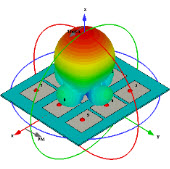求教 关于s参数的使用
05-08
小弟 第一次尝试准备做280-435mhz il 2db ripple 0.5db rl >14db 这个指标的滤波器 现在用5阶且比雪夫型做出电路 s参数仿真了 却不知道 il 和 rl 这两个指标如何使用。请求大神帮助。拜谢。
where the vertical bars indicate magnitude. Thus, a large positive return loss indicates the reflected power is small relative to the incident power, which indicates good impedance match from source to load.
Return loss is identified with the S-parameter S11 from two-port network theory.
Insertion Loss usually also represented in dB, is given by:
Since insertion loss is, by definition, a loss (or, negative gain), the resulting negative sign is often neglected. Insertion loss is commonly mistaken for (above), and deserves special consideration here. The difference between them is that penalizes the device for mismatch at the input, while insertion loss is not a function of the input or source impedances. This can be further expressed as:
附上g的定义:
Scalar logarithmic gain
The scalar logarithmic (decibel or dB) expression for gain (g) is
This is more commonly used than scalar linear gain and a positive quantity is normally understood as simply a 'gain'... A negative quantity can be expressed as a 'negative gain' or more usually as a 'loss' equivalent to its magnitude in dB. For example, a 10 m length of cable may have a gain of - 1 dB at 100 MHz or a loss of 1 dB at 100 MHz.
那小编知道Insertion Loss和Return Loss的定义是什么吗?写出来S参数计算这两个Loss的公式来就清楚了。
不要说你不知道,就算你真的不知道,上网去搜。外事问谷歌、内事问百度、学术问维基,天涯咱就先不用去了……。
仿真出的结果里 在匹配的条件 下 就是反射系数等于S(1,1) 可以算得RL。只要算频带内最值的情况么?特地搜了下。那个IL还是不太清楚怎么算。
找到了。Google还是好用 上次用百度搜的云里雾里的。下次再也不用百度了。
在维基百科上可以查到Return Loss、Insertion Loss、S Parameters和Gain的定义:
Return loss is the negative of the magnitude of the reflection coefficient in dB. Since power is proportional to the square of the voltage, return loss is given by,

where the vertical bars indicate magnitude. Thus, a large positive return loss indicates the reflected power is small relative to the incident power, which indicates good impedance match from source to load.
Return loss is identified with the S-parameter S11 from two-port network theory.
Insertion Loss usually also represented in dB, is given by:

Since insertion loss is, by definition, a loss (or, negative gain), the resulting negative sign is often neglected. Insertion loss is commonly mistaken for (above), and deserves special consideration here. The difference between them is that penalizes the device for mismatch at the input, while insertion loss is not a function of the input or source impedances. This can be further expressed as:


附上g的定义:
Scalar logarithmic gain
The scalar logarithmic (decibel or dB) expression for gain (g) is

This is more commonly used than scalar linear gain and a positive quantity is normally understood as simply a 'gain'... A negative quantity can be expressed as a 'negative gain' or more usually as a 'loss' equivalent to its magnitude in dB. For example, a 10 m length of cable may have a gain of - 1 dB at 100 MHz or a loss of 1 dB at 100 MHz.
谢谢小编 仿真结果洗白。tuning中。
射频专业培训教程推荐











